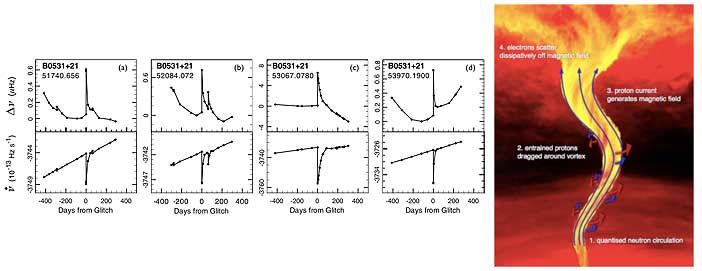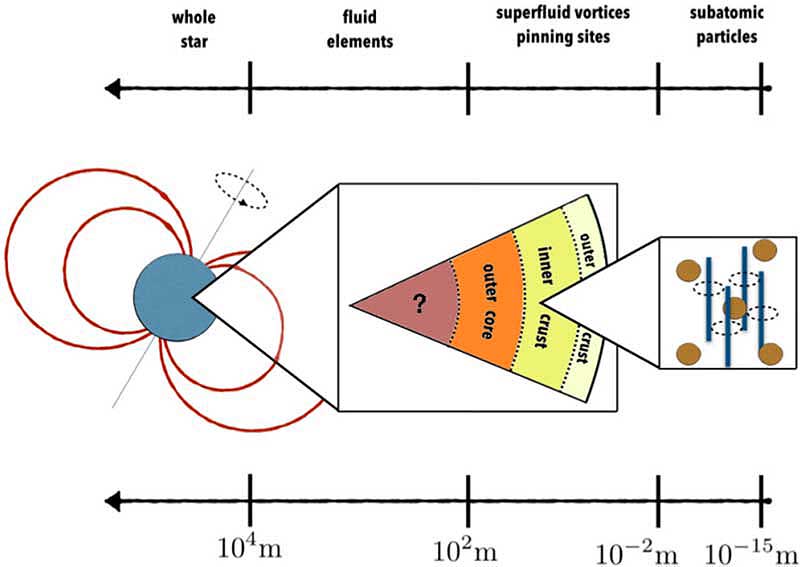INT Program INT-19-1a
Quantum Turbulence: Cold Atoms, Heavy Ions, and Neutron Stars
March 18 - April 19, 2019
Highlights
Turbulence phenomena are characterized by cascades and inverse cascades of energy through different length scales. Quantum superfluids, despite being dissipationless, also exhibit turbulent phenomena which is typically characterized by the creation and dynamics of topological defects such as superfluid vortices and vortex rings. In nuclear physics, quantum turbulence is expected in the crust and core of neutron stars, where it may play a key role in the phenomenology of pulsar glitches - sudden rapid increases in the precession rate despite a slow continuous loss of angular momentum. Quantum turbulence also plays a role in the hydrodynamic description of heavy ion collision.
This 5-week INT workshop brought the nuclear physics community together with both theorists and experimentalist studying cold atoms and superfluid liquid helium - two terrestrial realizations of quantum turbulence with direct experimental access. During the program, we discussed the nature of quantum turbulence in both 2D and 3D systems, heard about a variety of theoretical techniques used to model turbulent systems, and brought theorists together with experimentalists to brainstorm about how the next generation of cold-atom and helium experiments can be used to answer fundamental questions about nuclear physics.
The program began with a discussion of turbulence in 2D systems, and a characterization of self-similar cascades near non-thermal fixed points. The second week of the program functioned as an experimental symposium, presenting the state of the art in quantum turbulence. During the following weeks, turbulence was discussed in the context of neutron stars, with various techniques presented to study finite-temperature systems, and for scaling from microscopic to macroscopic scales.
All of the talks have been recorded and are available for viewing online.

Various pulsar glitches see in the Crab Pulsar. These glitches are thought to be manifestations of quantum turbulence, resulting from massive unpinning of superfluid vortices and flux tubes (right) in the crust and/or core of the neutron star. (Images from talk by Danai Antonopoulou and Nils Andersson.)

Behaviour of vortices passing through the interface between two phases of superfluid helium in a rotating cylinder of superfluid helium. (Image from talk by Vladimir Eltsov.)

Quantum vs. classical turbulence. Both forms of turbulence involve vorticity, but differ at a microscopic scale. Quantum turbulence ends at the scale of quantized vortices whereas classical turbulence is ended by dissipation induced by viscosity. At a large scale, however, both systems look remarkably similar. (Image from the talk of Wei Guo.)

Huge dynamic range over which quantum turbulence manifests as pulsar glitches in neutron stars. At a microscopic level, one has superfluid vortices and electromagnetic flux tubes which are thought to pin on nuclei or similar defects in the crust of the neutron star. At a macroscopic scale, these microscopic theories must be replaced by macroscopic models of vortex filament motion, and ultimately an effective hydrodynamic description that can be scaled up to the size of a neutron star. Comparison with superfluid experiments is one way of validating the transition from microscopic to macroscopic theory. (Image from Bryn Haskell.)

Vortex tangle and associate turbulent cascades for total vortex length (left) and the kinetic energy spectrum as a function of wavelength (right). (Image from talk by Carlo Barenghi.)